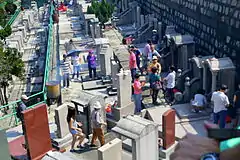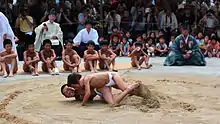Double Ninth Festival
The Double Ninth Festival (Chongyang Festival in mainland China and Taiwan or Chung Yeung Festival in Hong Kong and Macau; Chōyō no Sekku[5] (重陽の節句) or Kiku no Sekku (Japanese: 菊の節句); Jungyangjeol (Hangul: 중양절); Tết Trùng Cửu (chữ Hán: 節重九), observed on the ninth day of the ninth month in the Chinese calendar, is a traditional Chinese holiday, mentioned in writings since before the Eastern Han period (before AD 25).[2]
| Double Ninth Festival | |
|---|---|
 Chai Wan Cemetery, Hong Kong, 2015 | |
| Official name | Chongyang Festival (重陽節) (重阳节)[1] |
| Also called | Chung Yeung Festival (重陽節 ) Chōyō no Sekku (重陽) Jungyangjeol (중양절)[2][3] Chrysanthemum Festival (菊の節句) Tết Trùng Cửu (節重九)[4] |
| Observed by | Chinese, Japanese, Koreans, Vietnamese[2] |
| Type | Cultural, Asian |
| Date | 9th day of the 9th lunar month |
| 2022 date | 4 October |
| 2023 date | 23 October |
| 2024 date | 11 October |
| 2025 date | 29 October |
| Frequency | Annual |
| Double Ninth Festival | |||||||||||||||||||||||||||
|---|---|---|---|---|---|---|---|---|---|---|---|---|---|---|---|---|---|---|---|---|---|---|---|---|---|---|---|
| Chinese name | |||||||||||||||||||||||||||
| Traditional Chinese | 重陽節 | ||||||||||||||||||||||||||
| Simplified Chinese | 重阳节 | ||||||||||||||||||||||||||
| |||||||||||||||||||||||||||
| Vietnamese name | |||||||||||||||||||||||||||
| Vietnamese alphabet | Tết Trùng Cửu | ||||||||||||||||||||||||||
| Chữ Hán | 節重九 | ||||||||||||||||||||||||||
| Korean name | |||||||||||||||||||||||||||
| Hangul | 중양절 | ||||||||||||||||||||||||||
| Hanja | 重陽節 | ||||||||||||||||||||||||||
| |||||||||||||||||||||||||||
| Japanese name | |||||||||||||||||||||||||||
| Kanji | 重陽の節句 | ||||||||||||||||||||||||||
| |||||||||||||||||||||||||||
According to the I Ching, nine is a yang number; the ninth day of the ninth month in the Chinese calendar (or double nine) has extra yang (a traditional Chinese spiritual concept) and is thus an auspicious date.[6] Hence, the day is also called "Double Yang Festival" (重陽節).[7] It is customary to climb a mountain,[8][9] drink chrysanthemum liquor,[8][9] and wear the zhuyu (茱萸) plant Cornus officinalis. (Both chrysanthemum and zhuyu are considered to have cleansing qualities and are used on other occasions to air out houses and cure illnesses.)
On this holiday, some Chinese also visit the graves of their ancestors to pay their respects.[9] In Hong Kong and Macau, whole extended families head to ancestral graves to clean them and repaint inscriptions and lay out food offerings such as roast suckling pig and fruit, which are then eaten (after the spirits have consumed the spiritual element of the food). Chongyang cake is also popular.[7] Incense sticks are burned.[10]
Origin
The origins of the festival date back as early as the Warring States period.[11]
According to legend, the traditions of hiking and drinking chrysanthemum wine on this day began with the Han dynasty man Fei Changfang and his disciple Huan Jing.[6] One year, Fei advised Huan to bring chrysanthemum wine and food and climb a mountain with his family on the ninth day of the ninth month.[6] Huan followed his master's instructions, and when he returned home he found that his livestock had all suddenly died; if he had not climbed the mountain as instructed, the same would have happened to him and his family.[9][6][12]
An alternative origin story involves intrigue in the imperial court of Emperor Gaozu of Han. As part of Empress Lü's jealous plot against Consort Qi, the latter's maid was forced out of the imperial palace.[7] The maid, surnamed Jia (贾; 賈), told the common people that in the palace it was customary to wear dogwood and drink chrysanthemum wine on the ninth day of the ninth month, and these customs spread more widely.[7]
In 1966, Taiwan rededicated the holiday as "Senior Citizens' Day",[13] underscoring one custom as it is observed in Mainland China, where the festival is also an opportunity to care for and appreciate the elderly.[14]
Double Ninth may have originated as a day to drive away danger, but like the Chinese New Year, over time, it became a day of celebration. In contemporary times it is an occasion for hiking and chrysanthemum appreciation.[6][1] Other activities include flying kites, making flower cakes, and welcoming married daughters back home for visiting.[1]
Stores sell rice cakes (糕 "gāo", a homophone for height 高) with mini colorful flags to represent zhuyu. Most people drink chrysanthemum tea, while a few traditionalists drink homemade chrysanthemum wine. Children learn poems about chrysanthemums, and many localities host chrysanthemum exhibits. Mountain climbing races are also popular; winners get to wear a wreath made of zhuyu.
Festivities outside Greater China
Japan

In Japan, the festival is known as Chōyō but also as the Chrysanthemum Festival (菊の節句, Kiku no Sekku) and it is one of Japan's five sacred ancient festivals (sekku).[15][16][17] It is most commonly celebrated on the 9th day of the 9th month according to the Gregorian calendar rather than the lunar calendar, i.e. on September 9. It is celebrated at both Shinto shrines and Buddhist temples.[18] The festival is celebrated in the wish for the longevity of one's life and is observed by drinking chrysanthemum sake and eating dishes such as chestnut rice (kuri-gohan) and chestnuts with glutinous rice (kuri-mochi).[17]
Korea
In Korea, the festival is known as Jungyangjeol (중양절), and it is celebrated on the 9th day of the 9th month.[3] Koreans would consume chrysanthemum leaves in pancakes. As the festival is meant to celebrate and cultivate good health, outdoor activities such as carrying dogwood, climbing hills or mountains for picnics, and gazing at chrysanthemum blossoms are carried out.[2][3]
Gallery
 Participants arrive at the Chai Wan Cemetery, Hong Kong, 2015
Participants arrive at the Chai Wan Cemetery, Hong Kong, 2015 Chai Wan Cemetery Hong Kong, 2015
Chai Wan Cemetery Hong Kong, 2015 Chai Wan Cemetery, Hong Kong, 2015
Chai Wan Cemetery, Hong Kong, 2015 Xian Tang Village, Dongguan, China, 2015
Xian Tang Village, Dongguan, China, 2015 Xian Tang Village, Dongguan, China, 2015
Xian Tang Village, Dongguan, China, 2015
See also
- Double Seventh Festival
- Qingming Festival, a day to visit and clean up the cemeteries
- Curse of the Golden Flower, a Chinese film in which the plot takes place around the Chrysanthemum Festival.
References
- Zhao, Rongguang (2015). A History of Food Culture in China. SCPG Publishing Corporation. p. 14. ISBN 978-1938368165.
- Roy, Christian (2004). Traditional Festivals: A Multicultural Encyclopedia. pp. 116. ISBN 978-1576070895.
- National Folk Museum of Korea (2015). Encyclopedia of Korean Seasonal Customs: Encyclopedia of Korean Folklore and Traditional Culture. Gil-Job-Ie Media. p. 232.
- "Tết Trùng Cửu - Sự thật và Ý nghĩa của nó".
- Choyo no Sekku at kikuko-nagoya.com
- Stepanchuk, Carol (1991). Mooncakes and Hungry Ghosts: Festivals of China. San Francisco: China Books & Periodicals. pp. 89–91. ISBN 0-8351-2481-9.
- Wei, Liming (2010). Chinese Festivals: Traditions, Customs and Rituals (Second ed.). Beijing. pp. 54–57. ISBN 9787508516936.
{{cite book}}: CS1 maint: location missing publisher (link) - Eberhard, Wolfram (1952). "The Mid-Autumn Festival". Chinese Festivals. New York: H. Wolff. pp. 110–111.
- 陳瑞璋 (2001). 認識中國傳統節日和風俗. Hong Kong. p. 45. ISBN 9621419573.
{{cite book}}: CS1 maint: location missing publisher (link) - Chung Yueng Festival, Discover Hong Kong
- "The Double Ninth Festival". China Daily. November 2, 2022. Retrieved November 2, 2022.
- 中國節日的故事 (in Chinese) (1st ed.). Taipei: 將門文物出版社. 2001. pp. 226–237. ISBN 957-755-300-1.
- "Chrysanthemums, Climbing, and Consideration of the Elderly - Double Ninth Day". Gio.gov.tw. Archived from the original on May 15, 2008. Retrieved 2008-10-07.
- "Archived copy". Archived from the original on 2007-10-28. Retrieved 2007-10-25.
{{cite web}}: CS1 maint: archived copy as title (link) - "Chrysanthemum Festival". The Free Dictionary. 2010. Retrieved 2015-06-08.
- 菊の節句(重陽の節句) [The Chrysanthemum Festival (The Choyo Festival)] (in Japanese). 英語対訳で読む日本の文化. Retrieved 7 November 2018.
- "Chapter 3: Kiku no sekku". Japan Federation of Pottery Wholesalers’ Co-operative Association. 3 June 2016. Retrieved 7 November 2018.
- "Autumn (July - September)". Tokyo Metropolitan Library. Retrieved 7 November 2018.
- Recueil de cent textes annamites. F.H. Schneider. 1905.
- Bùi, Xuân Mỹ (2001). Lễ tục trong gia đình người Việt. Văn hóa thông tin. p. 330.
